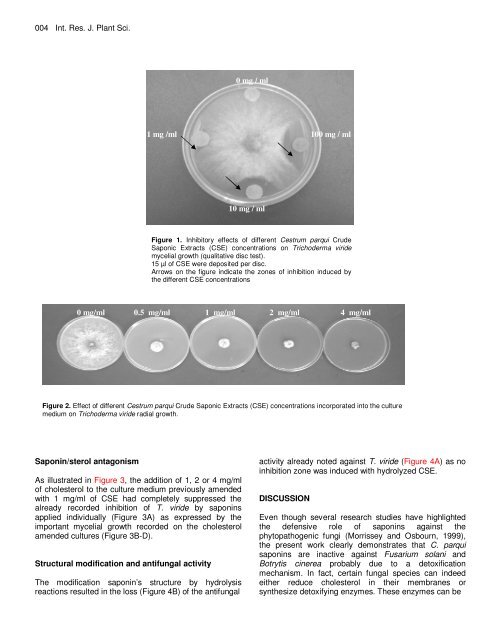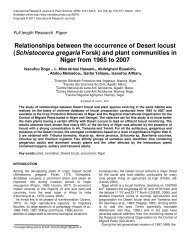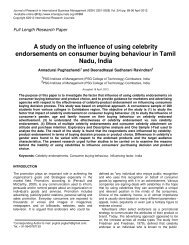Antibacterial and antifungal activities of Cestrum parqui saponins ...
Antibacterial and antifungal activities of Cestrum parqui saponins ...
Antibacterial and antifungal activities of Cestrum parqui saponins ...
You also want an ePaper? Increase the reach of your titles
YUMPU automatically turns print PDFs into web optimized ePapers that Google loves.
004 Int. Res. J. Plant Sci.<br />
Figure 1. Inhibitory effects <strong>of</strong> different <strong>Cestrum</strong> <strong>parqui</strong> Crude<br />
Saponic Extracts (CSE) concentrations on Trichoderma viride<br />
mycelial growth (qualitative disc test).<br />
15 µl <strong>of</strong> CSE were deposited per disc.<br />
Arrows on the figure indicate the zones <strong>of</strong> inhibition induced by<br />
the different CSE concentrations<br />
Figure 2. Effect <strong>of</strong> different <strong>Cestrum</strong> <strong>parqui</strong> Crude Saponic Extracts (CSE) concentrations incorporated into the culture<br />
medium on Trichoderma viride radial growth.<br />
Saponin/sterol antagonism<br />
1 mg /ml<br />
As illustrated in Figure 3, the addition <strong>of</strong> 1, 2 or 4 mg/ml<br />
<strong>of</strong> cholesterol to the culture medium previously amended<br />
with 1 mg/ml <strong>of</strong> CSE had completely suppressed the<br />
already recorded inhibition <strong>of</strong> T. viride by <strong>saponins</strong><br />
applied individually (Figure 3A) as expressed by the<br />
important mycelial growth recorded on the cholesterol<br />
amended cultures (Figure 3B-D).<br />
Structural modification <strong>and</strong> <strong>antifungal</strong> activity<br />
The modification saponin’s structure by hydrolysis<br />
reactions resulted in the loss (Figure 4B) <strong>of</strong> the <strong>antifungal</strong><br />
0 mg / ml<br />
10 mg / ml<br />
activity already noted against T. viride (Figure 4A) as no<br />
inhibition zone was induced with hydrolyzed CSE.<br />
DISCUSSION<br />
100 mg / ml<br />
0 mg/ml 0.5 mg/ml 1 mg/ml 2 mg/ml 4 mg/ml<br />
Even though several research studies have highlighted<br />
the defensive role <strong>of</strong> <strong>saponins</strong> against the<br />
phytopathogenic fungi (Morrissey <strong>and</strong> Osbourn, 1999),<br />
the present work clearly demonstrates that C. <strong>parqui</strong><br />
<strong>saponins</strong> are inactive against Fusarium solani <strong>and</strong><br />
Botrytis cinerea probably due to a detoxification<br />
mechanism. In fact, certain fungal species can indeed<br />
either reduce cholesterol in their membranes or<br />
synthesize detoxifying enzymes. These enzymes can be














